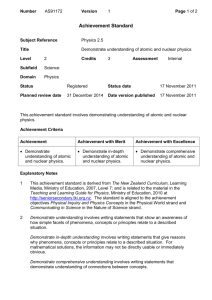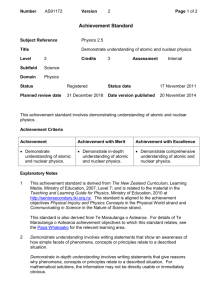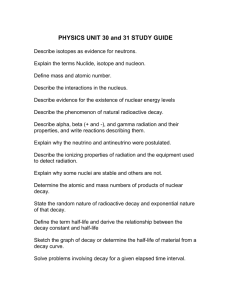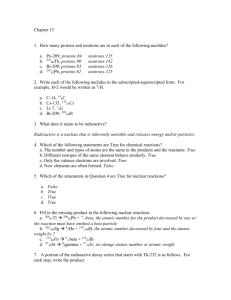Ch. 4 and Ch. 25 Outline
advertisement
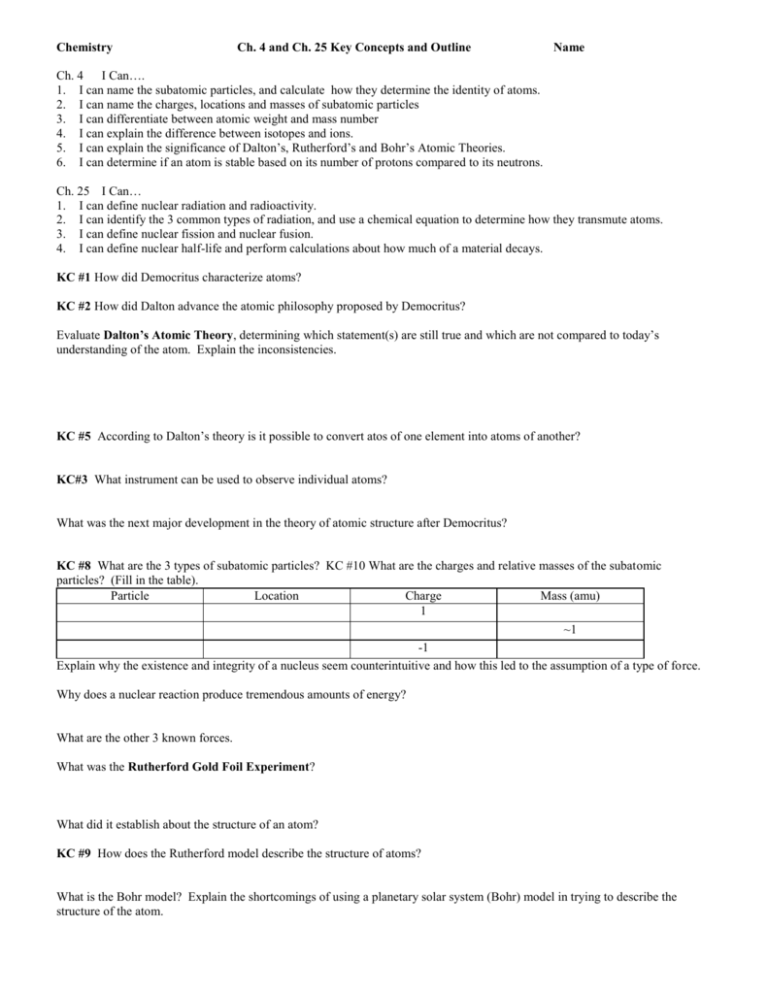
Chemistry Ch. 4 and Ch. 25 Key Concepts and Outline Name Ch. 4 I Can…. 1. I can name the subatomic particles, and calculate how they determine the identity of atoms. 2. I can name the charges, locations and masses of subatomic particles 3. I can differentiate between atomic weight and mass number 4. I can explain the difference between isotopes and ions. 5. I can explain the significance of Dalton’s, Rutherford’s and Bohr’s Atomic Theories. 6. I can determine if an atom is stable based on its number of protons compared to its neutrons. Ch. 25 I Can… 1. I can define nuclear radiation and radioactivity. 2. I can identify the 3 common types of radiation, and use a chemical equation to determine how they transmute atoms. 3. I can define nuclear fission and nuclear fusion. 4. I can define nuclear half-life and perform calculations about how much of a material decays. KC #1 How did Democritus characterize atoms? KC #2 How did Dalton advance the atomic philosophy proposed by Democritus? Evaluate Dalton’s Atomic Theory, determining which statement(s) are still true and which are not compared to today’s understanding of the atom. Explain the inconsistencies. KC #5 According to Dalton’s theory is it possible to convert atos of one element into atoms of another? KC#3 What instrument can be used to observe individual atoms? What was the next major development in the theory of atomic structure after Democritus? KC #8 What are the 3 types of subatomic particles? KC #10 What are the charges and relative masses of the subatomic particles? (Fill in the table). Particle Location Charge Mass (amu) 1 ~1 -1 Explain why the existence and integrity of a nucleus seem counterintuitive and how this led to the assumption of a type of force. Why does a nuclear reaction produce tremendous amounts of energy? What are the other 3 known forces. What was the Rutherford Gold Foil Experiment? What did it establish about the structure of an atom? KC #9 How does the Rutherford model describe the structure of atoms? What is the Bohr model? Explain the shortcomings of using a planetary solar system (Bohr) model in trying to describe the structure of the atom. Describe the structure of the Modern Atomic Theory. KC #25 What distinguishes the atoms of one element from the atoms of another? What is atomic number? What is mass number? What is an isotope? KC #27 How do the isotopes of a given element differ from one another? What is the atomic weight? What is an ion? Is it possible to change the number of p+ (protons) to create either an isotope or an ion? Explain Ch. 25 What eventually starts to happen to atoms as they get more and more subatomic particles in them? What is nuclear radiation? KC #1 How does an unstable nucleus release energy? KC #2 What are the three main types of nuclear radiation? (and how do they change an atom?) Describe how a nuclear equation, especially in relation to radioactive decay, follow the Laws of Conservation of Energy. What is a nuclear half life? KC #10 How much of a sample of radio-isotope remains after one half-life? After two half-lives? KC #11 What are two ways that nuclear transmutation can occur? KC #17 How are fusion reactions different from fission reactions? KC #15 Explain what happens in a nuclear chain reaction? What is the capability of an average nuclear fission missile? What is enriched uranium? What is plutonium? How does this relate to the world society? Chemistry Element Ch. 4 and 25 Worksheet Symbol Atomic # Atomic Mass Protons Neutrons Sodium Br Name Electron s 11 Mass # 80 208 32.07 Hydrogen O -1 16 2 9 -2 1 10 5 4 18 36 9.01 Common Isotope 22 45 82 Charge -1 Nuclear Radiation Reactions Write a full balanced equation for each example Alpha Decay of Pa-231 Beta decay of Fr-223 Alpha decay of Sm-149 Beta decay of Pm-165 Alpha decay of Md-249 Beta decay of At-198 What is a half life? After two half lifes of time, what fraction is left of the original sample? You have 1kg of Carbon-14, which undergoes beta particle decay, and has a half life of 5,730 years. How much time has gone by, if you have ¼ your original sample left? How much time has gone by if you have 1/16 of your original sample left? How much time has gone by if you have 0.5kg left of your sample? How much time has gone by if you have 0.125kg left of your sample? How many kg are left of the sample after 17,190 years? What fraction is left of the sample after 28,650 years? Consider the graph below. Count Rate is the number of atoms yet to decay in a given radioactive sample How many days is the half life of the material? At how many days is ¼ of the material left? How many half lifes have gone by at that point? What would be the amount of material (count) if the graph extended to 70 days? What would the count be 20 days before the testing was started?

